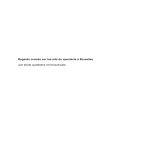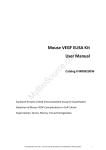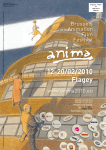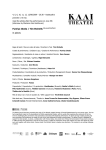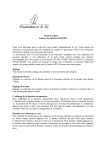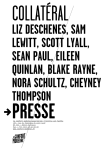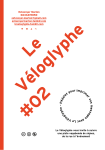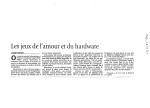Download Els Dietvorst_A5
Transcript
DUNCORMICK / BRUSSELS CREATION Els Dietvorst A R T- C Œ U R - M E R C I ( P E R F O R M A N C E ) O N E W A S K I L L E D F O R B E A U T Y, T H E O T H E R O N E W A S S H O T, T H E T W O O T H E R S D I E D N A T U R A L LY ( E X H I B I T I O N ) THE RABBIT AND THE TEASEL (FILM) 02 - 24.05.2014 B RUSSEL / BRUXELLES / BRUSSELS KUNSTENFESTIVALDESARTS ART-CŒUR-MERCI (PERFORMANCE) Kaaistudio’s 3/05 – 18:00 EN (no translation) A project by Els Dietvorst Performance by Els Dietvorst & Angelique Willkie Presentation Kunstenfestivaldesarts, Kaaitheater Production Firefly ONE WAS KILLED FOR BEAUTY, THE OTHER ONE WAS SHOT, THE TWO OTHERS DIED NATURALLY (EXHIBITION) Argos 3/05 > 29/06 Wednesday to Sunday – 11:00 > 18:00 A project by Els Dietvorst Presentation Kunstenfestivaldesarts, Argos THE RABBIT AND THE TEASEL (FILM) Kaaitheater 15/05 – 20:30 EN > NL / FR 50min A project by Els Dietvorst Presentation Kunstenfestivaldesarts, Kaaitheater Co-production Kunstenfestivaldesarts, Kaaitheater (Brussels) Production Tondo Films Supported by Vlaams Audiovisueel Fonds Meet the artist after the film on 15/05 DON’T FORGET TO LOOK OTHER PEOPLE IN THE EYES NL EEN STEDELIJKE JAGER-VERZAMELAAR Kunstenares en documentairemaakster Els Dietvorst is geboeid door mensen die in de marge leven. Het sociale conflict is een weerkerend thema in haar werk, zo ook in Art-Cœur-Merci, geïnspireerd op het leven van de Kameroenees ACM (Art-Cœur-Merci). Dietvorst leerde ACM acht jaar geleden kennen. Hij overleefde aan de rand van de stad, in een krot langs het kanaal Brussel-Charleroi. Als een stedelijke jager-verzamelaar scharrelde hij zijn eigen voedsel bijeen en maakte hij zijn kleren van wat wij achterlaten in de kledingcontainers van Oxfam. Hoewel hij zijn omgeving niet tot last was, werd hij weggejaagd en zijn onderdak platgegooid. ACM was sterk en fragiel, een (levens)kunstenaar. De kunstenares volgde hem verschillende jaren, notitieboekje en camera in de hand. Een documentaire-trilogie biedt ons een blik op het leven van de filosoof-zwerver en zijn strijd om een waardig bestaan. Van het verzamelde materiaal maakte Els Dietvorst een meerschermige filmprojectie en een bijhorende performance op basis van de tekst I’m going to my chickens door Angélique Wilkie. Het doet ons stilstaan bij essentiële vragen over het leven, maar ook bij stedelijke en economische ontwikkelingen, de globalisering van de markt en het toenemend individualisme. 5 NL ZOEKEN NAAR HET ALLEDAAGSE In 2005 presenteerde Els Dietvorst in Brussel The Return of the Swallows, een project dat resulteerde in een reeks kortfilms, een langspeelfilm en een multimediale installatie die ze zes jaar eerder startte in de Anneessenswijk, vlakbij het Brusselse Zuidstation. In 2012 startte ze met The Black Lamb, een multimediaal project in en over haar leefomgeving. Net zoals bij haar Brusselse werken probeert ze alle aspecten van het leven, werken, dromen op het Ierse platteland door middel van films, tekeningen, verhalen, sculpturen tot leven te wekken. Net zoals bij de zwaluwen doet ze dit niet op een romantiserende, esthetiserende manier, maar met een sterke betrokkenheid en in voortdurende interactie met reële en fictieve personages. Dietvorst lijkt vooral gefascineerd te zijn door hoe mens (en dier) interageren met elkaar, met de omgeving en hoe (over)leven mogelijk is in een intrinsiek vijandige en onaangepaste omgeving. Een tegenstem zonder alternatief Beide projecten, die een tijdsboog van vijftien jaar overspannen, zijn zowel in hun opzet, hun methodiek als hun schaal aan elkaar verwant en kunnen als een diptiek worden opgevat. Meer dan een subjectieve en artistieke representatie van een werkelijkheid, waarbij de kunstenaar op zoek gaat naar zowel dagelijksheid als transcendentie in min of meer extreme situaties (of toch situaties en leefomstandigheden die voor de gemiddelde geïnteresseerde in hedendaagse kunst als extreem overkomen), fungeren die projecten als een metafoor voor een condition humaine die verder rijkt dan de individuele verhalen van deze projecten. Dat werkt als een tegenstem: de kunstenaar registreert en toont een microrealiteit die haaks staat op het beeld van de ideale samenleving die we dagelijks via media, berichtgeving en reclame ingelepeld krijgen en die we maar al te vaak liever negeren dan omarmen. Maar de veelheid van individuele verhalen en beelden die Dietvorst ons presenteert overstijgt tegelijk elk clichébeeld over die marginale werkelijkheid. Ze werken verruimend en vormen eerder een soort aanvulling dan een correctie op het heersende maatschappijbeeld. Maar Dietvorst gaat verder. Ze presenteert geen alternatief en toont de dingen zoals ze zijn. Dingen die integraal deel uitmaken van de wereld waarin we leven. Ze produceert geen utopisch wereldbeeld, noch een complete dystopie. Met de kracht van de verbeelding en de focus op de 6 NL menselijke verhalen, het leven en het overleven schept ze een wereld die de onze zou kunnen zijn, waarin we ons herkennen en waarmee we ons tot op zekere hoogte kunnen identificeren. Ze houdt ons een spiegel voor waarin we gemeenschappelijke verlangens, strategieën en verhalen gereflecteerd zien. Het werk van Els Dietvorst toont vooral beelden en verhalen uit een niet-samenpersbare ruimte. Wat ze toont speelt zich af op een lokaal microniveau. Het is niet het inzoomen op aspecten die deel uitmaken van onze realiteit, zoals de boom onlosmakelijk deel uitmaakt van het bos, maar wel het tonen van een andere ruimte die tegelijk deel uitmaakt van en volledig los lijkt te staan van het grotere geheel. Er kunnen hierbij parallellen gezien worden met het onderzoek dat Paul Vandenbroeck deed bij het maken van de tentoonstelling Azetta. Voor dit project ging hij op zoek naar een zuivere vorm van vrouwelijkheid. Door de extreme isolatie van de vrouw in Berberstammen vond Vandenbroeck in de getoonde tapijten een bijna zuiver vrouwelijk cultuurproduct. Dietvorst zoekt in haar werk naar zuivere vormen van doodgewone menselijkheid, naar wat – bijna vervreemdend – alledaags is. Analoog met de methodiek van Vandenbroeck, kan gesteld worden dat ze dat alledaagse weet te vinden in situaties waarin dit zich in extreme omstandigheden afspeelt. In een wereld waarin het verste continent slechts een telefoongesprek van ons verwijderd is, toont het werk van Els Dietvorst ons dat hoe klein de wereld ook wordt, we altijd ergens wonen, op een bepaalde en bepalende plaats verblijven die stipuleert hoe we met elkaar en met de werkelijkheid omgaan. Zowel de boer als de dakloze ageert en reageert in het werk van Dietvorst op een directe manier op zijn omgeving en probeert deze op allerlei manieren de zijne te maken. Het voert ons onvermijdelijk terug naar de complexiteit van het hier en het nu en toont aan dat globalisering in ideële zin nooit absoluut is. Opsommen en verzamelen Een ander opvallend element is de veelheid. Hoewel tekeningen, films, verhalen en sculpturen autonoom zijn, zijn ze ook onlosmakelijk met elkaar verbonden en genereren ze betekenis ten opzichte van elkaar. 7 NL In zijn roman Het leven een gebruiksaanwijzing beschrijft Georges Perec het leven in een groot appartementsgebouw in Parijs. Elke kamer in het gebouw krijgt een apart hoofdstuk en de lezer wordt op een bijna opsommende manier ingewijd in de details van het dagelijkse leven. Zoals de titel aangeeft wil hij de lezer, in een steeds meer gefragmenteerde wereld, een houvast aanreiken om die werkelijkheid te vatten en te begrijpen. De strategie die Perec hier hanteert is die van de gedetailleerde opsomming. De wereld als geheel is vandaag onmogelijk nog te begrijpen. Net door de werkelijkheid op te sommen, en daarmee talig, of in het geval van Dietvorst beeldig te maken slaagt de kunstenaar erin om terug grip te krijgen. De onderwerpen die Dietvorst in haar werk beschrijft zijn niet samen te vatten in een enkel beeld. Er is een veelheid nodig, en enkel vanuit die veelheid krijgt de kijker terug grip op het universele alledaagse. De enige manier om iets te beschrijven dat zich eigenlijk aan elke beschrijving onttrekt is voor Els Dietvorst de opsomming. Ze verzamelt stukken en fragmenten van de wereld en boetseert, verfilmt, tekent, verhaalt dit in beelden. Niet zozeer om de toeschouwer te wijzen op bepaalde mistoestanden, nog minder om door middel van kunst de wereld te redden, maar wel om aan zichzelf en aan de toeschouwer een houvast te bieden, om orde te scheppen in de chaos en vanuit een opgesomde werkelijkheid een spiegel voor te houden waarin we terug voeling krijgen met het universeel dagelijkse, met het gewone dat in een zotte wereld steeds meer als ongewoon ervaren wordt. Rolf Quaghebeur 8 NL HET DAGELIJKSE (OVER)LEVEN Kunstenares en documentairemaakster Els Dietvorst verhuist in 2010 van Brussel naar Duncormick, een dorpje op het Ierse platteland. Samen met haar partner Orla Barry bouwt ze er een nieuw bestaan op. De kunstenares geraakt er gaandeweg geïntrigeerd door wat er zich rondom haar afspeelt en in 2012 haalt ze opnieuw haar camera boven. Ze volgt haar buren in hun dagelijkse (over)leven en brengt ook haar eigen ervaringen in beeld. Dit resulteert in een reeks indringende videogetuigenissen, die ze bundelt in de webdocumentaire The Black Lamb. De onconventionele levensstijl van haar Ierse medeplattelandsbewoners staat haaks op de waan van alledag. Haar buren getuigen over een leven op het ritme van de seizoenen, los van materialiteit. De korte getuigenissen van TJ Butler – de jongste telg van veehandelaars van de derde generatie – in The Black Lamb vormen uiteindelijk de basis voor een groter project: The Rabbit and the Teasel (‘Het konijn en de wolkaarder’). In deze langspeelfilm transformeert Dietvorst Butlers relaas tot een modern plattelandsdrama, waarin de rauwe realiteit van een jaar vol regen de boer tot wanhoop drijft. Of zoals Butlers vader het verwoordt: “Even if farmers are as tough as nails, this season is soul destroying”. Slechts wie de gevolgen van een losgeslagen klimaat aan den lijve ondervindt, kan hierover getuigen, omdat het de kern van zijn bestaan overhoop gooit. Het maakt de ziel kapot. Fictie en autobiografische elementen verweven zich in deze film tot een lyrisch sprookje dat de toeschouwer meesleept in een universum van schoonheid, dood en verval. The Rabbit and the Teasel borduurt verder op de vaak anti-utopische thema’s uit Dietvorsts eerdere filmwerk: sociaal-maatschappelijk conflict en het gevecht dat het leven is. Ze vertrekt opnieuw van haar fascinatie voor outsiders, mensen die hun leven radicaal omgooien en in de marge belanden. De kunstenares reflecteert over haar eigen leven, over wat het betekent om ver van het comfort van de stad te (over)leven. Ze vraagt zich af wat er gebeurt met een mens als hij terug aan het begin van de voedselketen komt te staan en troont de kijker mee in een consumptievrije samenleving, die overgeleverd is aan wat de seizoenen opleveren. Ze appelleert aan het collectieve geheugen van de lokale gemeenschap. Haar dorpsgenoten doen hun relaas, filmen en acteren. Fictie en realiteit verweven zich tot een modern sprookje. The Rabbit and the Teasel zoomt in op een ontwrichte leefwereld. De gevolgen van de klimaatverandering zijn 9 NL latent aanwezig. De natuur weet niet langer hoe zich te gedragen. De gevolgen zijn ontnuchterend. Als filmmaker huldigt Dietvorst de credo’s van regisseurs als Robert Bresson, Andrej Tarkovski en Werner Herzog. Ze is bij uitstek een filmmaker die zich positioneert tussen de mens en het leven zoals het is (Bresson), en evenzeer een filmmaker die geen onderscheid maakt tussen het leven dat ze leidt en de film die ze maakt, wiens leven in dienst staat van die film (Tarkovski) en net zo een filmmaker die documentaires draait die in werkelijkheid ‘vermomde’ fictiefilms zijn (Herzog). Voor dit “experiment op den buiten”, zoals ze het zelf noemt, bouwt Dietvorst gestaag een vertrouwensrelatie op met haar protagonisten, bewoners van het platteland rondom haar. In The Rabbit and the Teasel vermengen autobiografische elementen zich met gebeurtenissen uit heden, verleden en toekomst. In een tijdloze setting ontvouwt zich een even betoverende als confronterende hedendaagse parabel. De film werd bijna integraal opgenomen op de Breen Farm in Lough, Duncormick. Het huis werd in 1832 gebouwd door de familie Furlong. Deze boerderij, die oorspronkelijk een landbouwbedrijf was, werd door James en Bridie Breen in 1968 omgebouwd tot een melkveehouderij. Vandaag beheert hun zoon John de Breen Farm. De elfjarige Caelan Hunt vertolkt de rol van TJ Butler, die met zijn moeder Liz, zijn vader, veehandelaar Bernard en zijn broer Éinri in het naburige dorpje Gorteen woont. Zelf woont Caelan in Sligo, aan de andere kant van Ierland. Hij ontmoette Els Dietvorst en haar team tijdens de jaarmarkt van Tullamore, waar enkele runderen van zijn vader de prijskamp wonnen. Hij is dol op voetbal en is een hevig supporter van Chelsea. Hij had nooit eerder geacteerd. De dertienjarige Sam Molyneux speelt TJ Butlers broer. Sam gaat naar school in St. Anne’s in Rathangan en kijkt ernaar uit om naar de middelbare school te gaan. Sam houdt van lezen en is heel geïnteresseerd in de militaire geschiedenis van de Tweede Wereldoorlog. Ook Sam had nog nooit eerder geacteerd en deze film was dan ook een geweldige ervaring voor hem. Seamus McCoy verhuisde als jonge tiener van Birmingham, Engeland naar Wexford, Ierland. Hij is er sinds jaren actief in het lokale 10 NL amateurtheater. Seamus was heel blij toen Els hem voorstelde de rol van TJ Butlers vader te vertolken in The Rabbit and the Teasel. Alice McCoy is geboren en getogen in Duncormick. Zij is de vrouw van Seamus in het werkelijke leven en vervult deze rol ook vol overgave in de film. Alice is kok van opleiding en levert hier haar eerste acteerprestatie. Componiste en muzikante Laura Hyland volgt Els’ filmwerk van bij het ontstaan van The Black Lamb in 2012. Enkele maanden geleden vroeg Els haar om een lied te schrijven voor The Rabbit and the Teasel. Naast het filmscript verwees ze naar Woodie Guthries Pastures of Plenty en Screamin’ Jay Hawkins. Laura Hyland hield de Amerikaanse folktraditie in het achterhoofd, maar beriep zich vooral op de klank van ontbering en natuur die doorzindert in haar ‘eigen’ Iers-Britse folktraditie. Elk vers uit het lied is geïnspireerd op een video uit The Black Lamb of het filmscript, maar Laura gaf de muziek ook een lyrische toets van onschuld en magie mee; ze heeft TJ Butler gevat in een lied. De voice-over wordt vertolkt door Liam Heffernan, bekend van Ierse televisieseries zoals The Clash of the Ash (1987), Strength and Honour (2007) en Deich gCoisceim (2000). Na de première in het Kaaitheater is de film te zien bij Argos, waar de tentoonstelling One Was Killed For Beauty, The Other One Was Shot, The Two Others Died Naturally met nieuw werk van Els Dietvorst loopt. www.theblacklamb.org www.therabbitandtheteasel.com 11 NL BIO Els Dietvorst (1964) behaalde een master in de Schone Kunsten aan Sint-Lukas Antwerpen. Aanvankelijk drukte ze zich uit via sculptuur en installatiekunst, maar gaandeweg werden tekeningen, teksten en vooral video haar belangrijkste media. In haar werk focust ze op communicatie, intermenselijke relaties en sociaal conflict en op anti-utopische thema’s als de condition humaine en de outsider. Haar werken nemen vaak de vorm aan van jarenlange projecten, waarin ze rechtstreeks met haar sociale omgeving werkt. De terugkeer van de zwaluwen aan het Brusselse Anneessensplein en Lied voor de prijs van een geit of haar activiteiten in de gesloten jeugdinstelling in Mol zijn hier mooie voorbeelden van. Samen met kunstenares Orla Barry richtte Els Dietvorst het collectief Firefly op, waarvan ze tien jaar directeur was. Haar werk werd onder meer getoond in M HKA (Antwerpen), Witte de With (Rotterdam), het Paleis voor Schone Kunsten (Brussel), Kunsthalle Exnergasse (Wenen), La Source du Lion (Casablanca), Danielle Arnaud Gallery (Londen) en Nicole Klagsbrun (New York). In 2009 was ze samen met Dirk Braeckman curator van het Time Festival in Gent. Ze is gastdocente aan IT Carlow-Wexford Campus, KU Leuven en het KASK in Gent. In 2010 ruilde Els Dietvorst Brussel in voor het Ierse kustdorp Duncormick, waar ze sinds 2012 aan een nieuw langlopend filmproject werkt: The Black Lamb. In mei 2014 toont ze naar aanleiding van het Kunstenfestivaldesarts een reeks nieuw werk in Brussel. Els Dietvorst op het Kunstenfestivaldesarts 2003 De laatste nacht van de nachtman 2004 The March, The Burden, The Desert, The Boredom, The Anger 2009 The Stone Road & Night Shop (met Firefly) 12 MAKE A RULE THAT TEACHERS ADMIT WHEN THEY ARE WRONG. ADULTS SHOULD HAVE TO ACKNOWLEDGE THAT THEY CAN BE TERRIBLY WRONG. FR UN CHASSEUR-CUEILLEUR URBAIN L’artiste et documentariste Els Dietvorst est fascinée par les personnes qui vivent en marge de la société. Ainsi, le conflit social est un thème récurrent dans son œuvre. Il en va de même dans Art-Cœur-Merci, inspiré de la vie du Camerounais ACM (Art-Cœur-Merci). Dietvorst l’a rencontré il y a huit ans. Il survivait dans un taudis le long du canal Bruxelles-Charleroi, aux abords de la ville. En tant que chasseur-cueilleur urbain, il grappillait de-ci de-là sa nourriture et s’habillait avec les vêtements que nous abandonnons dans les conteneurs d’Oxfam. Bien qu’il n’était pas une charge pour son environnement et ne causait aucun ennui, il fût chassé et son taudis rasé. ACM était fort et fragile, un artiste (de la vie). La projection du film sur plusieurs écrans et la performance d’Angélique Wilkie, inspirée du texte I’m going to my chickens d’Els Dietvorst, nous invitent à faire une halte face aux choses essentielles de la vie, mais aussi face aux développements urbains et économiques, à la mondialisation du marché et à l’individualisme croissant. 14 FR E N Q UÊTE D U Q U OTID I E N Els Dietvorst présentait en 2005 à Bruxelles The Return of the Swallows, un projet qui se concrétisa par une série de courts-métrages, un longmétrage et une installation multimédia créée six ans plus tôt dans le quartier Anneessens, à proximité de la gare du Midi à Bruxelles. Son projet multimédia The Black Lamb sur son lieu de vie a démarré en 2002. Comme dans ses œuvres bruxelloises, elle tente d’illustrer tous les aspects de la vie, du travail, des rêves dans la campagne irlandaise à travers des films, des dessins, des histoires, des sculptures. Comme pour les hirondelles (the Swallows), elle ne prend pas la voie d’une esthétique empreinte de romantisme, mais s’attache à l’engagement et à l’interaction continue avec ses personnages réels et fictifs. Dietvorst semble surtout fascinée par la manière dont les hommes (et les animaux) entrent en interaction entre eux, avec l’environnement, et dont la vie (ou la survie) est possible dans un milieu intrinsèquement hostile et inadapté. Une voix qui s’élève sans offrir d’alternative Les deux projets peuvent être considérés par leur objectif, leur méthode et leur échelle comme un diptyque. Plus que la représentation subjective et artistique d’une réalité dans laquelle l’artiste verrait dans le quotidien la transcendance de situations plus ou moins extrêmes (ou de situations et d’environnements ressentis comme extrêmes par l’amateur moyen d’art contemporain), ces projets fonctionnent comme une métaphore d’une condition humaine qui dépasse la dimension individuelle. C’est comme une voix qui s’élève contre une réalité : l’artiste enregistre et montre une micro-réalité contraire à l’image de la société idéale dont nous abreuvent les médias, l’actualité, la publicité, et que nous préférons le plus souvent ignorer qu’embrasser. Mais la diversité des histoires individuelles et des images que nous présente Dietvorst surmonte en même temps tous les clichés courants sur cette réalité marginale. Ses images vont bien au-delà et forment une sorte d’apport plutôt qu’une correction à la représentation dominante de la société. Dietvorst va bien plus loin encore. Elle n’offre aucune alternative et nous montre les choses comme elles sont. Les choses qui font partie intégrante du monde dans lequel nous vivons. Elle ne produit pas de représentation idyllique du monde, pas plus qu’une contre-utopie complète. Avec la force de l’imagination et en se concentrant sur les histoires humaines, la vie et la survie, elle crée un univers qui pourrait être le 15 FR nôtre, dans lequel nous nous reconnaissons et auquel nous pouvons dans une certaine mesure nous identifier. Elle nous tend un miroir de stratégies, d’histoires et de désirs communs à l’humanité. L’œuvre d’Els Dietvorst est constituée d’images et d’histoires émanant d’un espace non-compressible. Ce qu’elle nous montre se joue à un niveau local, un micro-niveau. Ce n’est pas un zoom photographique sur des aspects qui font partie de notre réalité, de la manière dont l’arbre fait partie de la forêt, mais la présentation d’un autre espace qui à la fois fait partie et se détache entièrement du grand tout. On peut y voir des parallèles avec la recherche effectuée par Paul Vandenbroeck pour l’exposition Azetta. Pour ce projet, il est parti en quête d’une forme pure de féminité. Dans les tapis tissés par les femmes berbères dans des conditions d’extrême isolement, Vandenbroeck a trouvé un produit culturel féminin presque pur. Dietvorst recherche dans son travail artistique des formes pures d’une humanité ordinaire, d’un quotidien presque aliénant. D’une manière analogue à celle de Vandenbroeck, elle trouve le quotidien dans des situations extrêmes. Dans un monde où un continent est à portée d’un coup de téléphone, l’œuvre d’Els Dietvorst nous montre que si le monde est devenu un village, nous vivons toujours dans un lieu déterminé et déterminant qui conditionne notre rapport à la réalité. L’agriculteur comme le SDF agit dans l’œuvre de Dietvorst de manière directe sur son environnement et tente de se l’approprier, chacun à sa manière. Cela nous ramène inévitablement à la complexité du maintenant et ici et montre que la mondialisation n’est jamais absolue au sens idéal. Récapituler et collecter Un autre aspect frappant de son œuvre est la profusion. Bien que ses dessins, ses films, ses histoires et ses sculptures aient une existence autonome, ils sont indissociables et génèrent un sens nouveau en relation les uns aux autres. Georges Perec décrit dans son roman La Vie mode d’emploi la vie dans un grand immeuble parisien. Chaque pièce du bâtiment fait l’objet d’un chapitre et le lecteur est initié aux détails du quotidien sous la forme 16 FR d’une récapitulation. Comme l’indique le titre, Perec cherche, dans un monde toujours plus fragmenté, à donner au lecteur des outils pour appréhender et comprendre cette réalité. La stratégie utilisée ici par l’auteur est celle de l’énumération détaillée car le monde d’aujourd’hui est devenu globalement incompréhensible. Dans l’énumération de la réalité à travers des mots, ou des images dans le cas de Dietvorst, l’artiste reprend prise sur elle. Les sujets que Dietvorst décrit dans son œuvre ne peuvent pas se réduire à une seule image. Il faut des images à profusion et ce n’est qu’avec cette profusion que le spectateur peut à nouveau appréhender le quotidien universel. Pour Els Dietvorst, la seule manière de décrire quelque chose qui se soustrait à toute description est la récapitulation. Elle rassemble des morceaux, des fragments du monde et les modèle, les filme, les dessine, les narre en images. Pas tant pour dénoncer devant le spectateur des situations abusives, encore moins pour sauver le monde par l’art, mais pour se donner à elle-même et au spectateur des repères, mettre de l’ordre dans le chaos et, à partir d’une réalité énumérée, tendre un miroir qui nous réconcilie avec le quotidien universel, avec un ordinaire considéré anormal dans un monde qui ne tourne pas rond. Rolf Quaghebeur 17 FR L A (S U R)V I E Q U OTID I E N N E En 2010, la documentariste et artiste Els Dietvorst quitte Bruxelles pour s’installer à Duncormick, un petit village de la campagne irlandaise. Avec sa partenaire, Orla Barry, elle y construit une nouvelle existence. Chemin faisant, l’artiste est intriguée par ce qui se déroule autour d’elle, et en 2012, elle décide de ressortir sa caméra et de filmer ses voisins dans leur (sur)vie quotidienne. Elle intègre également ses propres expériences aux images. Cela donne lieu à une série de témoignages étonnants qu’elle compile dans un documentaire mis en ligne, The Black Lamb. Le style de vie peu conventionnel des campagnards irlandais devenus ses co-villageois est à l’opposé de la routine quotidienne. Ils affichent un mode vie rythmé par les saisons, détaché du matériel. Les témoignages succincts de TJ Butler – le plus jeune descendant d’une troisième génération de marchands de bétail – dans The Black Lamb constituent finalement le point de départ d’un plus grand projet : The Rabbit and the Teasel (Le lapin et le cardeur). Dans ce long-métrage, Els Dietvorst transpose le récit de l’éleveur en un drame rural moderne dans lequel la dure réalité d’une année de pluie abondante pousse cet homme au désespoir. Ou comme l’exprime le père de Butler : « Même si les fermiers sont coriaces, cette saison sape le moral. » Seul celui qui découvre à ses dépens les conséquences d’un climat qui a perdu le nord peut en témoigner, parce que cela bouleverse l’essence de son existence et détruit son âme. Dans le film, éléments fictionnels et autobiographiques s’entremêlent et tissent un conte lyrique qui entraîne le spectateur dans un univers de beauté, de mort et de déclin. The Rabbit and the Teasel s’inscrit dans le prolongement des thèmes souvent anti-utopiques de l’œuvre filmique précédente d’Els Dietvorst : le conflit social et sociétal et le combat qu’est la vie. Elle part à nouveau de sa fascination pour les marginaux, des personnes dont la vie bascule de façon radicale et qui aboutissent dans la marge. L’artiste s’interroge sur sa propre vie, sur ce que signifie le fait de (sur)vivre loin du confort urbain. Elle se demande ce qui arrive quand une personne remonte à la source de la chaîne alimentaire et entraîne ainsi le spectateur dans une société exempte de consommation, livrée à ce que procurent les saisons. Elle fait appel à la mémoire collective de la communauté locale. Ses co-villageois racontent leur récit, filment et jouent. Fiction et réalité s’imbriquent en un conte moderne. The Rabbit and the 18 FR Teasel fait un gros plan sur un univers déstabilisé dans lequel les conséquences du changement climatique transparaissent en filigrane. La nature ne sait plus à quel saint se vouer et les effets donnent à réfléchir. En sa qualité de réalisatrice, Els Dietvorst rend hommage aux credos de réalisateurs comme Robert Bresson, Andreï Tarkovski et Werner Herzog. Elle est par excellence une cinéaste qui se positionne entre l’homme et la vie telle qu’elle est (Bresson) ; une réalisatrice qui ne fait pas de différence entre la vie qu’elle mène et le film qu’elle réalise, une femme dont la vie est au service du film qu’elle tourne (Tarkovski) ; et une documentariste qui filme la réalité camouflée en fiction (Herzog). Pour cette « expérience à la campagne » comme elle l’appelle elle-même, Els Dietvorst a graduellement établi une relation de confiance avec ses protagonistes, des habitants de la campagne avoisinante. Dans The Rabbit and the Teasel, les éléments autobiographiques se confondent avec des événements d’aujourd’hui, du passé et de l’avenir, dans un décor intemporel où se déploie une parabole contemporaine aussi envoûtante que troublante. Le film a été quasi intégralement tourné à la Breen Farm à Lough, Duncormick, une ferme agricole construite en 1832 par la famille Furlong, transformée en 1968 en exploitation de bétail laitier par James et Bridie Breen. Aujourd’hui, leur fils John gère la Breen Farm. Caelan Hunt, 11 ans, joue le rôle de TJ Butler. Il vit avec sa mère, Liz, son père, Bernard, marchand de bétail, et son frère, Éinri, dans le village voisin de Gorteen (dans le comté de Sligo, de l’autre côté de l’Irlande). Il a rencontré Els Dietvorst et son équipe durant le marché annuel de Tullamore où quelques bovins de son père ont remporté le concours. Il adore le football, est fervent supporter de Chelsea et n’a jamais tourné dans un film précédemment. Sam Molyneux, 13 ans, interprète le rôle du frère de TJ Butler. Sam va à l’école Ste-Anne à Rathagan et a hâte d’entrer en secondaire. Il aime lire et s’intéresse beaucoup à l’histoire militaire de la Seconde Guerre mondiale. Tout comme Caelan, il n’avait jamais joué auparavant et a vécu une expérience formidable sur le tournage de ce film. Adolescent, Seamus McCoy a déménagé de Birmingham en Angleterre à Wexford, en Irlande, où il est actif depuis des années dans le théâtre 19 FR amateur local. Seamus était ravi que Els Dietvorst lui propose d’interpréter le rôle du père de TJ Butler dans The Rabbit and the Teasel. Alice McCoy est née et a grandi à Duncormick. Épouse de Seamus à la ville, elle l’est aussi à l’écran. Cette cuisinière de formation s’est investie corps et âme pour son tout premier rôle au cinéma. La compositrice et musicienne Laura Hyland suit l’œuvre cinématographique d’Els Dietvorst depuis la genèse de The Black Lamb en 2012. Il y a quelques mois, Dietvorst lui a demandé d’écrire une chanson pour The Rabbit and the Teasel. Hyland y fait référence non seulement au scénario mais aussi à Pastures of Plenty de Woodie Guthrie et à Screamin’ Jay Hawkins. Avec la tradition du folk américain à l’esprit, Laura Hyland a surtout fait appel au son de la privation et de la nature qui teinte toujours aussi intensément sa propre tradition, celle du folk irlando-britannique. Chaque vers de la chanson s’inspire d’une vidéo extraite de The Black Lamb ou du scénario du film, mais Laura Hyland a également donné à la musique une touche lyrique d’innocence et de magie ; tout le personnage de TJ Butler est résumé en une chanson. La voix off est celle de Liam Heffernan, connu pour ses rôles dans des séries télévisées irlandaises comme The Clash of the Ash (1987), Strength and Honour (2007) et Deich gCoisceim (2000). Après la première au Kaaitheater, le film sera présenté à Argos, où se tient l’exposition One Was Killed For Beauty, The Other One Was Shot, The Two Others Died Naturally avec de nouvelles œuvres d’Els Dietvorst. www.theblacklamb.org www.therabbitandtheteasel.com 20 FR BIO Els Dietvorst (°1964) est détentrice d’un master en arts plastiques de l’Institut Sint-Lukas à Anvers. Au départ, elle s’exprimait par le biais de la sculpture et de l’art de l’installation, mais chemin faisant, le dessin, le texte et surtout la vidéo sont devenus ses médias de prédilection. Son œuvre se focalise sur la communication, les relations interpersonnelles et les conflits sociaux, ainsi que sur des thèmes anti-utopiques, comme la condition humaine de l’étranger et du marginal. Ses œuvres adoptent souvent la forme de projets à très long terme (plusieurs années) lors desquels elle travaille de manière directe avec son environnement social. Le retour des hirondelles, réalisé autour de la place Anneessens à Bruxelles, et Chant pour le prix d’une chèvre qui montre ses activités dans le centre éducatif fermé de Mol (dans la province d’Anvers) en sont de beaux exemples. Avec l’artiste irlandaise Orla Barry, elle a monté le collectif Firefly qu’elle a dirigé pendant dix ans. Son œuvre a été exposée au M HKA (Anvers), à Witte De With (Rotterdam), au Palais des Beaux-Arts (Bruxelles), à la Kunsthalle Exnergasse (Vienne), à La Source du Lion (Casablanca), à la Gallery Danielle Arnaud (Londres), et chez Nicole Klagsbrun (New York). En 2009, elle était co-commissaire du festival Time à Gand, aux côtés de Dirk Braeckman. Elle est professeure invitée à l’IT Carlow-Wexford Campus, la KU Leuven ainsi qu’au KASK à Gand. En 2010, elle a quitté Bruxelles pour s’établir dans le village artistique de Duncormick en Irlande où elle travaille depuis 2012 à un projet de film : The Black Lamb. En 2014, elle présente une série de nouvelles œuvres à Bruxelles dans le cadre du Kunstenfestivaldesarts. Els Dietvorst au Kunstenfestivaldesarts 2003 De laatste nacht van de nachtman 2004 The March, The Burden, The Desert, The Boredom, The Anger 2009 The Stone Road & Night Shop (avec Firefly) 21 TIJD ZOU MINDER SNEL VOORBIJ MOETEN GAAN EN A N U R B A N H U N T E R - G AT H E R E R Documentary maker and artist Els Dietvorst is fascinated by people who live on the fringes. This social conflict is a recurring theme in her work. As in Art-Cœur-Merci, inspired by the life of the Cameroonian man ACM (Art-Cœur-Merci). Dietvorst met him eight years ago. He was surviving in a shack on the outskirts of the city. An urban hunter-gatherer, he foraged for his food and made his clothes from what we leave behind in Oxfam clothing containers. He was not a burden to his environment, yet he was chased away and his shack was demolished. ACM was both strong and fragile, a (life) artist. The multi-screen film projection and the accompanying performance by Angélique Wilkie, based on Els Dietvorst’s piece I’m going to my chickens, make us reflect on the essential things in life, as well as on urban and economic developments, the globalisation of the market and increasing individualism. 23 EN T H E U N I V E R S A L E V E RY D AY N E S S In 2005 Els Dietvorst presented The Return of the Swallows in Brussels, a project that resulted in a series of short films, a feature film and a multimedia installation she had embarked on six year earlier in the Anneessens district near the Brussels South Station. In 2012 she started the multimedia project The Black Lamb – a project in and about her everyday world. Like in all her Brussels works, in this instance too, she attempted to bring to life all aspects of living, working and dreaming in the Irish countryside with films, drawings, stories and sculptures. And like in The Return of the Swallows she does not resort to a romanticizing aestheticizing language, but departs from a strong personal involvement and constant interaction with her real and fictitious characters. Dietvorst seems above all fascinated by the question how people (and animals) interact with each other and with the surroundings, and how living/surviving is possible in an intrinsically hostile and unsuitable environment. A voice of dissent without alternative Both projects, which cover a fifteen-year time span, are related to each other in both their aim, method and scale and can be viewed together as a diptych. They are more than a subjective and artistic representation of a reality: the artist is looking for both everydayness and transcendence in more or less extreme situations (or at least in situations and living conditions that are considered extreme by the average person interested in contemporary art). As such, both projects are a metaphor for a human condition that transcends the individual stories that have been integrated in the projects. This approach functions like a voice of dissent: the artist registers and shows a microreality that is at odds with the image of the ideal society we are fed every day in the media, news reports and advertising – a reality we all too often prefer to ignore instead of embracing. But the multitude of individual stories and images Dietvorst presents us transcends all clichés about this reality on the fringe of ours. The stories broaden our horizon and are more like an addition to than a correction of the prevailing view of society. Yet Dietvorst goes even further. She does not present an alternative but shows things as they are. Things that are an integral part of the world we live in. She does neither create a utopian world view, nor a complete 24 EN dystopia. Using the power of imagination and focusing on human stories, life and surviving, she creates a world that could be ours, in which we recognize ourselves and with which we can identify to a certain degree. She holds up a mirror in front of us. A mirror that reflects shared longings, strategies and stories. Above all, Dietvorst’s work shows us images and stories from a space that cannot be compressed. She shows us things that play at a local microlevel. She does not zoom in on aspects that are part of our reality, in the way that a tree is an inherent part of the wood – she shows us a different space that is at the same time part of a larger whole, but that also seems to be entirely separate of it. We could in fact see parallels here with the research Paul Vandenbroeck did for making the exhibition Azetta. For this project Vandenbroeck attempted to find a pure form of femininity. Due to the extreme isolation of women in the Berber tribes, Vandenbroeck discovered in the carpets he presented at the exhibition an almost pure female cultural product. In her own work, Dietvorst precisely looks for pure forms of common humanity, for that which is everyday in an almost alienating manner. It could be argued that analogous to Vandenbroeck and his methodology, Dietvorst succeeds in finding the everyday in situations in which it features in extreme circumstances. In a world in which the farthest continent is just one telephone call away from us, Dietvorst’s work shows us that no matter how small the world becomes, we can always live somewhere, i.e. in one well-defined and defining place, a place that conditions how we relate to each other and reality. In Dietvorst’s work, both the farmer and the homeless act and respond to the surroundings in a direct way in an attempt to appropriate them. This confronts us inevitably with the complexity of the here and now and also demonstrates that in a theoretical sense, globalization is never absolute. Enumerating and collecting Another striking feature is multiplicity. Though the drawings, films, stories and sculptures are autonomous works of art, they are inextricably linked with each other and they generate meaning through cross-referencing. 25 EN In his novel Life A User’s Manual, Georges Perec describes life in a large Parisian apartment block. A separate chapter is devoted to each room of the building and the reader is initiated in the details of everyday life, which are as it were enumerated. Like the title indicates, Perec wants to provide the reader with something to hold onto in an increasingly fragmented world, so that he or she is able to get a grip on reality and understand it. Perec’s strategy involves a detailed enumeration. The world as a whole is as such impossible to grasp today. Precisely by enumerating reality and turning it into language, or in the case of Els Dietvorst, into images, the artist succeeds in getting a grip on it again. The subjects Dietvorst describes in her work cannot be compressed into one single image. What is needed, is multiplicity, and only through this multiplicity the spectator will manage to get a grip again on the universal everyday. For Dietvorst, the only way to describe something that actually eludes description, is through enumeration. She collects scraps and fragments of the world and models them, films them, draws them, tells their story in images. Not so much to point out certain abuses and even less to save the world through art, but above all to provide something to hold on to for herself and the spectator, to create order where there was chaos and through the enumerated reality to hold up a mirror that allows us to tune in to the universal everydayness, to the common, to that which in a mad world is increasingly considered uncommon. Rolf Quaghebeur 26 EN E V E RY D AY L I F E / S U R V I V A L In 2010, documentary filmmaker and artist Els Dietvorst moved from Brussels to Duncormick, a village in the Irish countryside. Together with her partner Orla Barry, she built a new life. Since doing so, the artist gradually became intrigued by what was happening around her, and in 2012 picked up her camera once again. She follows her neighbours in their everyday lives/survival, and also brings her own experiences into the picture. This results in a series of probing video testimonies, which she bundles into the web documentary The Black Lamb. The unconventional lifestyle of her Irish co-rural-residents is at odds with the issues of the day. They testify to a life in the rhythm of the seasons, free of materiality. In The Black Lamb, the short testimonies of TJ Butler – the youngest member of a third generation of cattle dealers – ultimately form the basis of a larger project: The Rabbit and the Teasel. In this feature-length film, Dietvorst transforms Butler’s story into a modern rural drama, in which the raw reality of a year full of rain drives the farmer to despair. Or, as Butler’s father puts it: “Even if farmers are as tough as nails, this season is soul destroying.” Whoever has experienced the consequences of a runaway climate first-hand can attest to this, because it turns the core of one’s existence on its head. It ruins the soul. In this film, fiction and autobiographical elements weave themselves into a lyrical tale that drags the viewer into a universe of beauty, death, and decay. The Rabbit and the Teasel builds on many anti-utopian themes from Dietvorst’s earlier film work: socio-social conflict and the struggle that is life. Again, she starts with her fascination for outsiders, people whose lives have radically changed course and who end up in the margin. The artist reflects on her own life, what it means for her to live/survive far from the comforts of the city. She wonders what happens to a person when they arrive back at the beginning of the food chain, and entices the viewer into a consumption-free society reliant on what the seasons deliver. She appeals to the collective memory of the local community. Her fellow villagers narrate, film, and act. Fiction and reality are interwoven into a modern fairy tale. The Rabbit and the Teasel zooms in on a dislocated environment. The effects of climate change are latent. Nature no longer knows how to behave. The implications are sobering. As a filmmaker, Dietvorst honours the creeds of directors like Robert Bresson, Andrei Tarkovsky, and Werner Herzog. She is pre-eminently a 27 EN filmmaker who positions herself between man and life as it is (Bresson), and equally, a filmmaker who makes no distinction between the life she leads and the film she makes, whose life is in the service of that film (Tarkovsky), and, just as much, she is a filmmaker who makes documentaries that in reality are ‘disguised’ fictional films (Herzog). For this ‘experiment on the outside’, as she calls it, Dietvorst steadily builds a relationship of trust with her protagonists, residents of the surrounding countryside. In The Rabbit and the Teasel, autobiographical elements mingle with events from the past, present, and future. In a timeless setting, a contemporary parable unfolds, as enchanting as it is confronting. The film was almost entirely shot at Breen Farm in Lough, Duncormick. The house was built in 1832 by the Furlong family. Originally an agricultural farm, it was rebuilt as a dairy farm in 1968 by James Bridie Breen. Their son John manages Breen Farm today. Eleven-year-old Caelan Hunt plays the role of TJ Butler. He lives with his mother Liz, his father and cattle dealer Bernard, and brother Éinri, in the neighbouring village of Gorteen (they live on the other side of Ireland in Sligo). He met Els and her team during the annual Tullamore fair, where some of his father’s cattle won the competition. He loves football and is an avid fan of Chelsea. He had never acted before. Thirteen-year-old Sam Molyneux plays TJ Butler’s brother. Sam goes to school at St. Anne’s in Rathangan and is looking forward to going to secondary school. Sam loves to read and is very interested in the military history of World War II. Sam had also never acted before, and this film was a great experience. As a young teenager, Seamus McCoy moved from Birmingham, England to Wexford, Ireland. He has been active in local amateur theatre for many years. Seamus was delighted when Els proposed he play the role of TJ Butler’s father in The Rabbit and the Teasel. Alice McCoy was born and raised in Duncormick. She is Seamus’s wife in real life and also diligently fulfils this role in the film. Alice is a trained cook and here delivers her first acting performance. Composer and musician Laura Hyland has followed Els’s film work since the origins of The Black Lamb in 2012. Several months ago, Els asked 28 EN her to write a song for The Rabbit and the Teasel. Besides the film script, she refers to Woodie Guthrie’s Pastures of Plenty and to Screamin’ Jay Hawkins. Laura Hyland kept the American folk tradition in the back of her mind, but relied primarily on the sound of deprivation and nature that shimmers through her ‘particular’ Irish/British folk tradition. Each verse of the song was inspired by a video from The Black Lamb or by the film script, but Laura also gave the music a lyrical touch of innocence and magic; TJ Butler captured in a song. The voice-over is performed by Liam Heffernan, known from Irish television series such as The Clash of the Ash (1987), Strength and Honour (2007), and Deich gCoisceim (2000). After the premiere at the Kaaitheater, the film can be seen at Argos, where the exhibition One Was Killed For Beauty, The Other One Was Shot, The Two Others Died Naturally, with new work by Els Dietvorst, is on show. www.theblacklamb.org www.therabbitandtheteasel.com 29 EN BIO Els Dietvorst (b. 1964) graduated at Sint-Lukas Antwerpen with a master’s degree in Fine Arts. Initially she expressed herself through sculpture and installation art, but gradually these mediums gave way to drawings, texts and above all video. The focus of her work is communication, inter-human relations and social conflict and anti-utopian themes like the human condition and the outsider. It often takes the form of long-term projects in which she works directly with her surroundings and those living there. Her projects The Return of the Swallows on the Anneessensplein in Brussels and Song for the Price of a Goat and her activities at the secure young offenders’ institution in Mol are good examples of this. Together with artist Orla Barry she set up her Firefly collective, a dynamic workplace for artists, of which she was the director for ten years. Her work has been shown at M HKA (Antwerp), Witte De With (Rotterdam), the Centre for Fine Arts (Brussels), Kunsthalle Exnergasse (Vienna), La source du lion (Casablanca), Gallery Danielle Arnaud (London) and Nicole Klagsbrun (New York). In 2009 she curated the Time Festival in Ghent with Dirk Braeckman. She is a visiting lecturer at IT Carlow-Wexford Campus, KUL (Leuven) and the KASK in Ghent. In 2010 she moved from Brussels to the coastal village of Duncormick in Ireland, where she has been working on a new long-term film project entitled The Black Lamb since 2012. In May 2014 she will be in Brussels for the Kunstenfestivaldesarts, showing a series of new work. Els Dietvorst at the Kunstenfestivaldesarts 2003 De laatste nacht van de nachtman 2004 The March, The Burden, The Desert, The Boredom, The Anger 2009 The Stone Road & Night Shop (w/ Firefly) 30 Ook te zien op het Kunstenfestivaldesarts / à voir aussi au Kunstenfestivaldesarts / also at the Kunstenfestivaldesarts Markus Öhrn Bergman in Uganda Cinéma Marivaux 8, 9, 10, 11/05 Roger Bernat/FFF Numax-Fagor-plus Cinéma Marivaux 16, 18, 20, 21, 22, 23/05 – 20:30 17/05 – 22:00 Milo Rau/International Institute of Political Murder The Civil Wars Beursschouwburg 17, 19, 20, 21/05 – 20:30 18/05 – 18:00 KUNSTENFESTIVALDESARTS BOX OFFICE POP UP BAR/RESTO MEETING POINT Boulevard Adolphe Maxlaan 98 1000 Brussel / Bruxelles +32 (0)70 222 199 (€0,30/min.) [email protected] www.kunstenfestivaldesarts.be CINÉMA MARIVAUX This year’s festival centre is made possible with the generous support of Hotel Marivaux
































